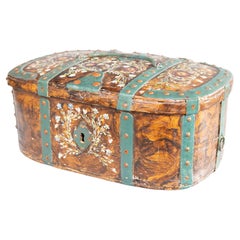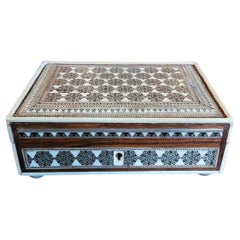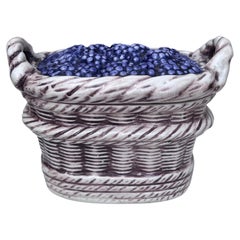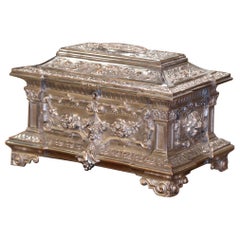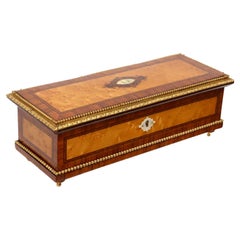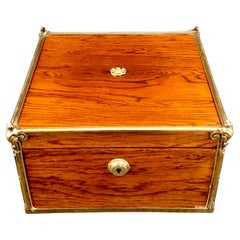Texas - Boxes
to
13
324
5
4
32
165
127
9
57
37
17
24
3
11
10
2
18
2
3
3
2
16
13
7
5
4
4
4
4
3
3
3
1
1
1
1
149
127
92
42
33
333
5,260
4,656
220
121
60
42
38
Height
to
Width
to
333
329
329
8
7
6
5
4
Item Ships From: Texas
19th Century Swedish Allmoge Folk Art Bentwood Chest
Located in Pearland, TX
An incredible Swedish hand-painted chest, having hand-forged iron straps and fittings. Original key included.
Category
Early 19th Century Swedish Folk Art Antique Texas - Boxes
Materials
Bentwood
19C Anglo Indian Bombay MOP Sadeli Mosaic Trinket Box
Located in Dallas, TX
PRESENTING a LOVELY 19C Anglo Indian Bombay MOP (Mother of Pearl) Sadeli Mosaic Trinket Box from circa 1875-85.
Gorgeously detailed and hand-crafted ‘sadeli mosaic’ inlay, from the Bombay Area, with deep greens with silver, pewter, mother of pearl, bone and ebony in geometric patterns.
The box case, is made of sandalwood but completely covered in MOP, bone, faux ivory, ebony and mosaic inlay.
Edged with faux ivory and banded with a different pattern of sadeli mosaic.
Some minor damage to the top (repair is obvious in pics) and ivorine replacements to some edging, but it still a BEAUTIFUL BOX and of real QUALITY!
The mosaic work is FABULOUS!
Box opens to reveal its original blue velvet lining.
It sits on 4 (recently added) silvered button feet.
SADELI MOSAIC: “Anglo Indian boxes were made in India for the English residents from the early part of the 18th century. They were brought back or sent back to England usually by the people who had commissioned them. From the beginning of the nineteenth century they were imported more commercially, although not in any significant numbers until the middle decades. They were very highly valued, especially the early ones, to the extent that the designs were copied on late 19th and early 20th century tins.
The ancient art of Sadeli Mosaic is said to have been introduced from Shiraz in Persia via Sind to Bombay, a long time before the Anglo Indian boxes were made. It was a technique, which required a high degree of skill and patience. It was executed very lavishly, in that the frequent cuts wasted a great amount of the precious materials used. The workmanship was however more than commensurable to the value of the materials.
Ivory, silver, pewter (or other metals), wood and horn were cut into faceted rods which were bound together to form geometric patterns. When the glue has set, the rods were sliced in transverse sections. This gave the maker a number of angled circular pieces in the original pattern. Several variations of patterns could be achieved by combining the materials in different ways. The ivory was sometimes dyed green to give an extra color.
The mosaic pieces in a combination of patterns, often separated by ivory, ebony, horn or silver stringing were used to veneer sandalwood boxes. In the early boxes, which date from the turn of the 18th to the 19th century, there are large panels of mosaic covering tops and sides of boxes. It took incredible skill to cover such large areas without any shakes or wavering of the pattern. The corners and joins on these boxes are impeccably matched.
The makers (reputed to be Persian) of Sadeli mosaic made in the first two decades of the 19th century displayed a total understanding of the qualities of the different materials they used. They combined substances, which can expand and contract according to atmospheric conditions with others, which are hard and unyielding. The result was a sharp definition of the lines and patterns, which made up the whole design.
On the early boxes the designs look deceptively simple. The fact is, they emerged from a culture, which had mastered geometry and understood how to generate a pattern from a set number of points. The patterns are so harmoniously combined that their incredible complexity is not immediately apparent.
The earliest Sadeli boxes...
Category
Late 19th Century Indian Anglo-Indian Antique Texas - Boxes
Materials
Silver
Small Mid-Century Majolica Blackberries Tureen
Located in Austin, TX
Small Mid-Century Majolica Blackberries Tureen.
Category
1950s French Mid-Century Modern Vintage Texas - Boxes
Materials
Ceramic
19th Century French Silver Plated over Bronze Jewelry Box with Repousse Motifs
Located in Dallas, TX
Place this elegant, antique Napoleon III silverplated box in your master bath to keep your jewelry safe and organized. Crafted in France circa 1870, and built of bronze, the rectangular casket with raised top, sits on small scrolled feet, and is dressed with lion face handles on both sides. All sides including the top are decorated with detailed repousse floral and leaf motifs in high relief throughout; the top is decorated with a oval medallion featuring Poseidon, one of the Twelve Olympians in ancient Greek religion and mythology...
Category
Mid-19th Century French Napoleon III Antique Texas - Boxes
Materials
Silver Plate, Bronze
Antique Paul Sormani Signed Parisian Napoleon III Period Glove Box
By Paul Sormani
Located in Forney, TX
A scarce very fine quality Napoleon III Period (1852-1870) gilt bronze ormolu mounted inlaid glove box by important Parisian ébéniste Paul Sormani (1817-1877)
Exquisitely hand-cra...
Category
Mid-19th Century French Napoleon III Antique Texas - Boxes
Materials
Brass, Ormolu
Regency Sterling Amboyna Box Paul Storr, London, 1813, Royal Coat of Arms
By Paul Storr
Located in West Palm Beach, FL
Regency Sterling Amboyna Box Paul Storr, London, 1813, Royal Coat of Arms
England, London, 1813
An exquisite Regency Sterling Amboyna Box, crafted by the renowned silversmith Paul...
Category
Early 19th Century English Georgian Antique Texas - Boxes
Materials
Sterling Silver
$5,200 Sale Price
20% Off
Vintage Decorative Malachite Box
Located in Houston, TX
Vintage decorative malachite box. This stunning rectangular lidded malachite box is the perfect coffee table accessory.
Category
1980s Unknown Hollywood Regency Vintage Texas - Boxes
Materials
Malachite
19th Century Bohemian Moser Enameled Amber Art Glass Jewel Casket
By Moser Glassworks
Located in Forney, TX
A stunning antique Bohemian enameled art glass hinged lid jewelry casket - table box by renowned luxury glass maker Moser.
Exquisitely hand-made in Bohemia (present day Czech Republic) in the late 19th century, artistic Art Nouveau period opulence, featuring very fine quality hand-blown polished...
Category
Late 19th Century Czech Art Nouveau Antique Texas - Boxes
Materials
Brass
Mudejar Small Coffer with Bone Inlays, Faux Tortoiseshell and an Iron Hardware
By Alfonso Marina
Located in Bosques de las Lomas, MX
The small Mudejar coffer is decorated with stars using bone inlay, faux tortoiseshell and ebony. It also has a masterfully crafted iron lock.
Category
21st Century and Contemporary Mexican Texas - Boxes
Materials
Iron
Hand-Painted Wood Small Coffer with Eagles and Iron Hardware
By Alfonso Marina
Located in Bosques de las Lomas, MX
The Eagles small coffer has rounded edges and is decorated with beautiful hand painted and Novo Hispanic motifs, all in shades of green.
Category
21st Century and Contemporary Mexican Texas - Boxes
Materials
Iron
Korean Lacquer and Mother of Pearl Inlay "Longevity" Box, 1930s, Korea
Located in Austin, TX
A fine and elegant Korean black lacquer and abalone mother of pearl inlay "longevity" box, circa 1930s, Korea.
The box, most likely used to sto...
Category
1930s Korean Showa Vintage Texas - Boxes
Materials
Wood, Lacquer, Abalone
Rare & Important 16th Century Italian Bronze Jacopo Lodovico del Duca Table Box
Located in Forney, TX
A magnificent antique fall-front box with scarce Medieval period bronze lockplate and hasp attributed to Jacopo and Lodovico del Duca.
Featuring an important Lockplate and Hasp designed circa 1570, exact date of manufacture unknown, attributed to the late 16th century Roman foundry of Jacopo 1520-1604) and Ludovico (1551-1601) del Duca, with no apparent signatures or hallmarks which is typical of the era, but we did not remove it and inspect the back.
Boxes such as this hand various uses but were frequently used by merchants as a writing box - slope during travel and trade, as a small coffer - strong box for storing important documents, money and valuables, as well as a jewelry casket.
This hand-crafted European drop-front box dates to the late 19th century, signed L'PUPLET, adorned with a significantly older Italian fine quality cast bronze lockplate with intricate Renaissance era reliefs, including figures, coat-of-arms, and elongated hasp, mounted on a chest of drawers form solid wooden case, wrapped in exotic Japanesque embossed and gilded metallic paper, having a locking fall-front panel with original key included, opening to reveal three interior drawers, all lined in red velvet. circa 1875
The visually striking textured wallpaper covering the box's exterior displays bamboo, birds, and flowers in the oriental Japanesque taste popular in Europe in the 1860s and 1870s following the forced reopening of foreign trade with Japan in 1858 and the ensuing Japonisme craze.
To the interior of the fall front panel is a gilt circular stamp with the somewhat obscured name of the workshop or store (likely) "L'PUPLET" and the city "Burxelles" which is in Brussels, indicating the box was likely made or retailed there.
Marks to box:
L'PUPLET, BRUXELLES
Inscription:
13, 14, 15 (Interior drawers inscribed on the verso of their backboards in script from top to bottom, respectively)
Provenance / Acquisition:
The origin of the elaborate lockplate with hasp on the front of the piece is more intriguing. At least 76 lockplates of this design have been recorded in major museums, private collections, and in the antiques trade across the Western World. For example, lockplates of this pattern are in the collections of the Rijksmuseum in Amsterdam, the State Museum of Prussian Cultural Heritage in Berlin, the Museum Cicico in Bologna, The Museum of Fine Arts in Boston, the Dallas Museum of Art in Texas, the Victoria & Albert Museum in London, the Museo di Palazzo Venezia in Rome, the State Hermitage Museum in St. Petersburg, and the National Gallery of Art in Washington, DC.[1]
Specialists in Renaissance bronzes, especially Charles Avery...
Category
16th Century Italian Japonisme Antique Texas - Boxes
Materials
Bronze, Metal
19th Century French Repousse Silver Plated on Copper Jewelry Box
Located in Dallas, TX
Place this elegant, antique Napoleon III copper box in your master bath to keep your jewelry safe and organized. Crafted in France circa 1880, the ornate ...
Category
Late 19th Century French Napoleon III Antique Texas - Boxes
Materials
Silver Plate, Copper
Majolica Onnaing Book Money Bank Box, circa 1900
By Onnaing
Located in Austin, TX
Majolica money bank books made by Onnaing. The piece was crafted, circa 1900.
Category
Early 1900s French French Provincial Antique Texas - Boxes
Materials
Ceramic
French Trompe L'oeil Pate Tureen Pillivuyt Mehun, circa 1900
By Charles Pillivuyt & Cie
Located in Austin, TX
French trompe L'oeil pate tureen Pillivuyt Mehun, circa 1900, Pate en croute.
Category
Early 1900s French French Provincial Antique Texas - Boxes
Materials
Ceramic
French Majolica Elephant Money Bank Saint Clement, Circa 1930
By Saint-Clément
Located in Austin, TX
French Majolica elephant money bank Saint Clement, Circa 1930.
Category
1930s French Art Deco Vintage Texas - Boxes
Materials
Ceramic
Small Majolica Pate White Rabbit Tureen
By Michel Caugant
Located in Austin, TX
Small Majolica white rabbit pate tureen or box circa 1950 signed Caugant.
Category
1950s French Country Vintage Texas - Boxes
Materials
Ceramic, Faience
French Majolica Duck Tureen, circa 1950
Located in Austin, TX
French Majolica duck tureen circa 1950.
Category
1950s French Rustic Vintage Texas - Boxes
Materials
Ceramic
Vintage Japanese Box from the 1970s
Located in Austin, TX
Perhaps originally designed as a Bento Box, this is a one-of-a-kind piece for your home-office or study desk. It has iconic 1970s modern lines and beautifully exemplifies the elevat...
Category
Late 20th Century Japonisme Texas - Boxes
Materials
Plastic
Majolica Money Bank Cat Circa 1900
Located in Austin, TX
French Majolica Money Bank Cat Circa 1900.
Category
Early 1900s French Country Antique Texas - Boxes
Materials
Ceramic
19th Century French Poplar Iron Brass and Leather Travel Trunk Jewelry Box
By Louis Vuitton
Located in Dallas, TX
Decorate a shelf or a master bath counter with this petite jewelry trunk. Crafted in France circa 1890 and built of poplar, the antique box is rectangu...
Category
Late 19th Century French Antique Texas - Boxes
Materials
Brass, Iron
Small Majolica Lidded Tureen Mixed Earths , circa 1890
Located in Austin, TX
Small Majolica Lidded Tureen Mixed Earths , circa 1890.
Category
1890s French French Provincial Antique Texas - Boxes
Materials
Ceramic
Korean Lacquer and Mother of Pearl Inlay Stationery Box, c. 1930's, Korea
Located in Austin, TX
An elegant Korean black lacquer and mother of pearl inlay stationery box with lion and peony, circa 1930's, Korea.
The rectangular box and cover ...
Category
1930s Vintage Texas - Boxes
Materials
Mother-of-Pearl, Softwood, Lacquer
Black Forest Decanter Set in Carved Box with St Louis Crystal Decanters/Stems
Located in Houston, TX
This cave a liqueur set is truly special because the box is exquisitely
Carved and has the original beveled glass. The decanters and stem
Ware are by St. Louis and the original la...
Category
Late 19th Century French Black Forest Antique Texas - Boxes
Materials
Crystal
$5,200 Sale Price / set
20% Off
Wedgwood Jasperware Pale Blue Small Circular Lidded Vanity Box
By Wedgwood
Located in Dallas, TX
PRESENTING A LOVELY Wedgwood Jasperware Pale Blue Small Circular Lidded Vanity Box.
Made by Wedgwood in England in 1982 and fully and properly marked/stamped on base.
Marked: “Wedgwood, Made in England …. “PH” … “T” ….. “82”.
2.25 inches tall lidded vanity box with a diameter of 3.25 inches.
Rolling vine and grape cameo reliefs, all over the lid and base sides.
Fabulous large pointed finial on the lid with floral cameo reliefs on the sides.
In very good original condition with no chips or cracks.
A ‘PERFECT’ match for the larger and almost identical, lidded jasperware box...
Category
20th Century English Neoclassical Revival Texas - Boxes
Materials
Ceramic
Antique Southeast Asian Filipino Maranao Silver Inlaid Brass Betel Nut Box
Located in Forney, TX
A scarce fine quality antique silver-inlaid solid brass betel nut box (Lutuan), dating to the second half of the 19th / early 20th century, hand-crafted in Mindanao, Philippines.
Boxes such as this were used to store the areca nut (also known as the betel nut) which would be wrapped in a betel leaf with lime paste and other ingredients, often tobacco, for chewing. Similar to the European tea caddy, these boxes often served as a way to impress while showing off ones wealth.
Betel chewing was prevalent in the southern Philippines as in much of the rest of Southeast Asia. Wealthier Maranao families on Mindanao were able to afford elaborate silver-inlaid brass betel boxes such as this example. Such boxes were used to show off to guests and from which they were offered betel and the other component such as leaves and lime to make up the betel quid.
Rare large size, most extant examples of such boxes tend to measure around 5 inches in length. At slightly more than 7.75 inches the example here is larger than most.
The distinctive decorative box features a very heavy strong-box like rectangular shaped chest form with canted corners, copper handles, and a conforming hinged lid, lifting open to reveal an interior divided into three compartments covered by four hinged lids. Each of these doors is inlaid with silver in stylized orchid flower patterns.
Exceptionally executed throughout, the arabesque silver inlaid exterior is decorated to the top with a large orchid motif within scrolling obid-obid (stylized rope) borders. The front, back and sides are inlaid with sets of stylized tail feathers of the sari-manok bird beneath which are unusual, highly stylized whimsical zoomorphic faces that appear like cat or tiger faces. (Such stylisation is accounted for by Southeast Asian Islamic preferences to avoid the overt and this potentially idolatrous representation of animal and human forms. Designs such as these are drawn from a local design repertoire that has its origins in wood carving.
Although the spread of Islam in the Philippines began in the 14th century, mostly through the influence of Muslim merchants from the western Malay Archipelago, decorative arts in this design remain exceptionally rare. This lutuan represents a fine example of Islamic metalwork from the most eastern outreach of Islamic art and civilisation: Mindanao island being significantly further east than even China – artwork from Islamic Southeast Asia remains chronically under-represented in the world’s major collections of Islamic art.
PROVENANCE / ACQUISITION
Acquired from highly reputable auction house, Austin Auction Gallery, established 1983, Austin, Texas.
References
Brownrigg, H., Betel Cutters...
Category
19th Century Philippine Islamic Antique Texas - Boxes
Materials
Silver, Brass, Bronze, Copper
English Honesty Box or Dispenser of Brass from the Georgian Era
Located in Austin, TX
A fine English honesty box or tobacco dispenser of brass from the Georgian era, circa 1820 - the rectangular brass box featuring a double-hinged lid and two compartments, one for coi...
Category
Early 19th Century English Georgian Antique Texas - Boxes
Materials
Metal, Brass
Austrian Majolica Gooseberries Basket, circa 1920
Located in Austin, TX
Austrian majolica gooseberries basket, circa 1920.
Category
1920s Austrian Rustic Vintage Texas - Boxes
Materials
Ceramic, Faience
19th Century French Bronze Box with Semi Precious Stones
Located in Houston, TX
19th century French bronze box with semi precious stones.
Lovely 19th century French Baroque style bronze box or jewel casket with semi...
Category
19th Century French Baroque Antique Texas - Boxes
Materials
Multi-gemstone, Bronze
Hollywood Regency Tessellated Box Or Chest
By Karl Springer, Maitland Smith, Enrique Garcel
Located in Houston, TX
Hollywood Regency Tessellated Box Or Chest.
This charming vintage tessellated box or tabletop chest would make a lovely jewelry box or decorative table box.
Category
1970s Unknown Hollywood Regency Vintage Texas - Boxes
Materials
Bone
Scarce Antique Tuareg Mauritania North Africa Mixed Metal Mounted Wood Chest
Located in Forney, TX
A rare and magnificent antique Tuareg peoples mixed metal mounted wooden chest / coffer / monumental table box.
Most impressive size, hand-crafted in ...
Category
Early 20th Century Mauritanian Tribal Texas - Boxes
Materials
Brass, Copper, Iron
19C Anglo Indian Vizigapatam Stamp Box
Located in Dallas, TX
Presenting an absolutely gorgeous and very rare 19C Anglo Indian Vizigapatam stamp box.
Made in Colonial India (the Time of the Raj) circa 1860.
Prob...
Category
Mid-19th Century Indian Anglo-Indian Antique Texas - Boxes
Materials
Bone, Shell
19th Century English Victorian Campaign Style Travel Desk Writing Box
Located in Forney, TX
A antique Victorian era English campaign style brass bound mahogany portable lap desk / writing slope with nicely aged patina. circa 1850
Commonly used by military officers in the f...
Category
Mid-19th Century English Campaign Antique Texas - Boxes
Materials
Brass
White Majolica Pate Tureen Digoin Sarreguemines Circa 1950
By Digoin & Sarreguemines
Located in Austin, TX
White Majolica Pate Tureen Digoin Sarreguemines Circa 1950.
Category
1950s French Rustic Vintage Texas - Boxes
Materials
Ceramic
Majolica Trompe L'oeil Napkin Egg Basket Box Sarreguemines
By Sarreguemines
Located in Austin, TX
19th Century Majolica napkin Trompe l'oeil box or basket/tureen with an egg on the handle signed Sarreguemines.
Category
1890s French Country Antique Texas - Boxes
Materials
Ceramic, Faience
Antique Hand - Painted Russian Round Trinket Box
Located in Pasadena, TX
A small round red, yellow and black trinket box. This vintage hand - painted box will be glamourous on a dresser, nightstand, or coffee table. Large eno...
Category
Late 20th Century Russian Tribal Texas - Boxes
Materials
Wood
19C Anglo Indian Highly Carved Teak Sadeli Mosaic Inlaid Sewing Box
Located in Dallas, TX
PRESENTING A LOVELY 19C Anglo Indian Highly Carved Sadeli Mosaic Inlaid Sewing Box.
Made in Bombay, India, circa 1880.
The box is made of sandalwood with highly carved raised teak wood panels on all sides, depicting temple scenes, animals and foliage.
The box is in a sarcophagus form.
It is edged in bone (and we can tell it is bone and not ivory, from the color and evidence of capillaries, which are not found in ivory), and banded with Bombay Sadeli mosaic and ebony veneer.
The lid opens to reveal a removable tray with various open compartments and lidded compartments. 5 lidded compartments, 1 unlidded compartment and 8 holders for thimbles, etc
The tray lifts to reveal a blue velvet (original) lined section, for storing jewelry etc, with sections for collars etc.
The inside of the lid has a removable mirror (the mirror is missing on this one but can easily be replaced). Behind the mirror is the original green velvet lining.
It has its original brass carry handles on the sides and sits on 4 silvered button feet (of recent origin).
Some repairs to the exterior and condition issues (priced accordingly), but still a LOVELY COLLECTIBLE box!
These boxes were made by superb Indian craftsmen, specifically for sale to the ruling British elite. These types of boxes, carved padouk and sandalwood, (whilst beautiful and superbly crafted) were of a lesser quality, than the more profusely and intricately mosaic inlay, tortoiseshell and ivory boxes, made for the British ‘Upper Classes’ in the areas of Bombay and Vizagapatam. These type of boxes were much more affordable back in 1880 (and indeed today) and would probably have been bought by mid-level diplomats, civil servants or visitors.
Sewing boxes (in general), were in EVERY Victorian home in Britain in the 19th century and like other boxes etc were ‘status symbols’ of your place in society! The more ornate the box, the more ‘Upper Class’ you were!
SADELI MOSAIC: “Anglo Indian boxes were made in India for the English residents from the early part of the 18th century. They were brought back or sent back to England usually by the people who had commissioned them. From the beginning of the nineteenth century they were imported more commercially, although not in any significant numbers until the middle decades. They were very highly valued, especially the early ones, to the extent that the designs were copied on late 19th and early 20th century tins.
The ancient art of Sadeli Mosaic is said to have been introduced from Shiraz in Persia via Sind to Bombay, a long time before the Anglo Indian boxes were made. It was a technique, which required a high degree of skill and patience. It was executed very lavishly, in that the frequent cuts wasted a great amount of the precious materials used. The workmanship was however more than commensurable to the value of the materials.
Ivory, silver, pewter (or other metals), wood and Horn were cut into faceted rods which were bound together to form geometric patterns. When the glue has set, the rods were sliced in transverse sections. This gave the maker a number of angled circular pieces in the original pattern. Several variations of patterns could be achieved by combining the materials in different ways. The ivory was sometimes dyed green to give an extra color.
The mosaic pieces in a combination of patterns, often separated by ivory, ebony, Horn or silver stringing were used to veneer sandalwood boxes. In the early boxes, which date from the turn of the 18th to the 19th century, there are large panels of mosaic covering tops and sides of boxes. It took incredible skill to cover such large areas without any shakes or wavering of the pattern. The corners and joins on these boxes are impeccably matched.
The makers (reputed to be Persian) of Sadeli mosaic made in the first two decades of the 19th century displayed a total understanding of the qualities of the different materials they used. They combined substances, which can expand and contract according to atmospheric conditions with others, which are hard and unyielding. The result was a sharp definition of the lines and patterns, which made up the whole design.
On the early boxes the designs look deceptively simple. The fact is, they emerged from a culture, which had mastered geometry and understood how to generate a pattern from a set number of points. The patterns are so harmoniously combined that their incredible complexity is not immediately apparent.
The earliest Sadeli boxes...
Category
Late 19th Century Indian Anglo-Indian Antique Texas - Boxes
Materials
Bone, Sandalwood, Teak
Antique French Louis XV Style Kingwood Marquetry Signed Bibus
By Paul Sormani
Located in Forney, TX
A stunning, rare fine quality French gilt bronze mounted Kingwood marquetry bibus (miniature bibliothèque). In the manner of/possibly by celebrated ébéniste Maison Paul Sormani; the ...
Category
Late 19th Century French Louis XV Antique Texas - Boxes
Materials
Brass, Bronze, Ormolu
French Majolica Money or Coin Bank Dog Circa 1900
Located in Austin, TX
French Majolica Money or Coin Bank Dog Circa 1900.
Category
Early 1900s French Country Antique Texas - Boxes
Materials
Ceramic
19th Century French Rosewood Travel Vanity Case by Peret and Dated 1855
Located in Dallas, TX
This beautiful antique jewelry box set was crafted in Paris, France, circa 1855. The box was made by Peret, a Parisian goldsmith, cabinetmaker and leather maker. Peret received a first class medal at the Exposition Universelle in 1855 (see engraving on the front). The box has an engraved crest on top with initials and crown, and several dividers inside. The compartments are outfitted with silver accessories, which include one square cut-glass bottle, two round glass bottles with silver tops and one rectangular cut-glass bottle. Inside the first tray, you'll also find two round powder glass containers with silver top, a long glass brush holder (brush included), a smaller rectangular shaving brush glass holder (brush included), all of them with a silver lid ornamented and finely chiseled with scrolls, shells and foliage, and a rectangular glass soap container with silver top. The next tray underneath features all the necessary for manicure, pedicure, hair cutting...
Category
Mid-19th Century French Napoleon III Antique Texas - Boxes
Materials
Silver
19th Century Sterling Silver Snuffbox Birmingham 1848 by Rolason Bros
By Rolason Brothers
Located in Dallas, TX
Lovely little sterling silver snuffbox, fully hallmarked with gold plated interior.
Lovely chasing on lid and sides, classic high Victorian repousse w...
Category
Mid-19th Century English High Victorian Antique Texas - Boxes
Materials
Sterling Silver
$585 Sale Price
54% Off
19th Century French Gothic Polished Black and Silver Cast Iron Strongbox Safe
Located in Dallas, TX
Keep your jewelry or important documents locked up in this small antique safe from Northern France. Crafted, circa 1880, the 52 pound cast safe has a chic two-tone black and silver paint finish. The heavy...
Category
Late 19th Century French Gothic Antique Texas - Boxes
Materials
Iron
Turkish Silver Wedding Box
Located in Austin, TX
One can get lost in the endless details within this piece's chiseled and embossed detailing. Each of the features on this Turkish Silver Wedding Box is like a mini vignette, displayi...
Category
Early 20th Century Turkish Balkan Texas - Boxes
Materials
Silver
$1,480 Sale Price
20% Off
French Green Majolica Money Bank Typewriter Circa 1950
Located in Austin, TX
French Green Majolica Money Bank Typewriter Circa 1950.
Category
1950s French Mid-Century Modern Vintage Texas - Boxes
Materials
Ceramic
Large Red Majolica Money Bank Squirrel Circa 1950
Located in Austin, TX
Large Red Majolica Money Bank Squirrel Circa 1950.
Category
1950s French Mid-Century Modern Vintage Texas - Boxes
Materials
Ceramic
Rare Majolica Box with Oysters and Snail Choisy Le Roi, circa 1880
By Choisy-le-Roi
Located in Austin, TX
Rare Majolica box with oysters and snail signed Hippolyte Boulenger Choisy Le Roi, circa 1880.
Measures: Height / 8", length / 15" on 6.5".
Category
1880s French Aesthetic Movement Antique Texas - Boxes
Materials
Ceramic, Faience, Majolica
Antique Chinese Decorated Lacquer Decorative Box
Located in Houston, TX
Antique Chinese lacquer decorated decorative box. This Stunning Chinese export hand decorated lacquered box is the perfect accessory for a coffee table or dressing table. Could be used for jewelry or important documents.
Category
1920s Chinese Chinese Export Vintage Texas - Boxes
Materials
Lacquer
19th Century English Rosewood & Mother of Pearl Jewelry Box
Located in Pearland, TX
A superb antique Victorian English rosewood jewellery box with fitted interior, a removable inner jewellery tray, and fully working lock and key, circa 1850. The lid and front of thi...
Category
Mid-19th Century English Victorian Antique Texas - Boxes
Materials
Mother-of-Pearl, Rosewood
$1,575 Sale Price
30% Off
French Majolica Coin Bank Boar Massier Circa 1890
By Delphin Massier
Located in Austin, TX
Extremely rare French Majolica Coin Bank Boar Massier Circa 1890.
Actually the only boar coin bank known.
Category
1890s French Country Antique Texas - Boxes
Materials
Ceramic
19C Anglo Indian Carved Teak Wood and Sadeli Mosaic Box
Located in Dallas, TX
PRESENTING A LOVELY 19th century Anglo-Indian Carved Teak Wood and Sadeli Mosaic Box, featuring a carving of a Hunt Scene.
Made circa 1870 in Bombay, India during the Rule of the Br...
Category
Late 19th Century Indian Anglo-Indian Antique Texas - Boxes
Materials
Silver, Pewter
Majolica Money Bank Tom Terrier Saint Clement, circa 1900
By Saint-Clément
Located in Austin, TX
Majolica money bank Tom Terrier Saint Clement, circa 1900.
Category
Early 1900s French Country Antique Texas - Boxes
Materials
Ceramic
19th Century French Repousse Silvered Metal Spice or Jewelry Box
Located in Dallas, TX
Crafted in southern France circa 1860, and octagonal in shape, the antique box is built of metal with a silvered finish with repousse floral and leaf motifs throughout. The decorative casket...
Category
Mid-19th Century Antique Texas - Boxes
Materials
Metal
French Majolica Box Dog in a Kennel Choisy-le-Roi, circa 1880
By Choisy-le-Roi
Located in Austin, TX
French Majolica box dog in a kennel signed Choisy le Roi , circa 1880.
Category
1880s French Rustic Antique Texas - Boxes
Materials
Ceramic
19th Century Majolica Goat Tobacco Jar Onnaing
By Onnaing
Located in Austin, TX
Majolica tobacco jar signed Onnaing, circa 1890.
Decorated with a goat and wheat and leaves.
Category
1890s French Rustic Antique Texas - Boxes
Materials
Majolica, Ceramic
19th Century French Repousse Brass Clad Coal Bin on Casters with Hunt Motifs
Located in Dallas, TX
Crafted in France, circa 1870, the antique brass coffer is mounted on a wooden frame, and stands on caster wheels. The slant top opens up with stopping chain revealing inside storage...
Category
Mid-19th Century French Napoleon III Antique Texas - Boxes
Materials
Brass
19C Anglo Ceylonese Lap Desk of Museum Quality
Located in Dallas, TX
Presenting an absolutely fantastic 19C Anglo Ceylonese lap desk of museum quality.
We can safely say that this is one of the finest lap desks we hav...
Category
Early 19th Century Sri Lankan Anglo-Indian Antique Texas - Boxes
Materials
Bone, Ebony, Sandalwood
Large Green Majolica Money Bank Squirrel Circa 1950
Located in Austin, TX
Large green Majolica Money Bank Squirrel Circa 1950.
Category
1950s French Mid-Century Modern Vintage Texas - Boxes
Materials
Ceramic
17th/18th Century Italian Venetian Marquetry Table Box
Located in Forney, TX
An important early antique Italian Renaissance table box, handcrafted in Northern Italy in the 17th/18th century, cassone chest form, richly inlaid, the top and front panel with fruitwood banding framing...
Category
18th Century Italian Renaissance Antique Texas - Boxes
Materials
Wood, Fruitwood
19C Anglo Ceylonese Specimen Wood Trinket Box
Located in Dallas, TX
PRESENTING A BEAUTIFUL and RARE 19C Anglo Ceylonese Specimen Wood Trinket Box.
Made in ‘Galle’, Ceylon (now Sri Lanka) circa 1860-80.
Made for the ex...
Category
19th Century Sri Lankan Anglo-Indian Antique Texas - Boxes
Materials
Bone, Hardwood, Ebony, Sandalwood
19th Century Victorian Majolica Bird Box Joseph Holdcroft
By Joseph Holdcroft
Located in Austin, TX
19th century Victorian Majolica turquoise box with a bird handle and white flowers attributed to Joseph Holdcroft.
Very rare shape box.
Category
1880s British Victorian Antique Texas - Boxes
Materials
Ceramic, Faience, Majolica
Recently Viewed
View AllMore Ways To Browse
Khatam Box
Moroccan Bone Box
Rosenthal Lidded Box
Lacquer Cigarette Case
Letter Post Box
Limoges Porcelain Eggs
Moorish Mother Of Pearl Box
Oriental Vanity
Regency Sewing Box
Russian Lacquer Box
Shaving Box
Antique Glass Trinket Box With Lid
Antique Indian Brass Plate
Antique Iron Strongbox
Antique Silk Top Hat
Antique Straw Box
Bone Casket
Bone Inlay Vanity
